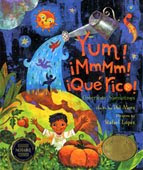 I am excited to share the news about the newest recipient of the NCTE Award for Excellence in Poetry for Children just announced today at the conference. The next recipient of this prestigious award for a poet's body of work is... drumroll... J. Patrick Lewis!
I am excited to share the news about the newest recipient of the NCTE Award for Excellence in Poetry for Children just announced today at the conference. The next recipient of this prestigious award for a poet's body of work is... drumroll... J. Patrick Lewis!Congratulations, Pat!
You so richly deserve this distinction.
NCTE established its Award for Excellence in Poetry for Children in 1977 to honor a living American poet for his or her aggregate work for children ages 3–13. You'll notice that NCTE gave the award annually until 1982 and every three years until 2009. In 2008 the Poetry Committee updated the criteria and changed the time frame to every other year.
Pat joins a select list of 15 prior recipients:
2009 Lee Bennett Hopkins
2006 Nikki Grimes
2003 Mary Ann Hoberman
2000 X. J. Kennedy
1997 Eloise Greenfield
1994 Barbara Esbensen
1991 Valerie Worth
1988 Arnold Adoff
1985 Lilian Moore
1982 John Ciardi
1981 Eve Merriam
1980 Myra Cohn Livingston
1979 Karla Kuskin
1978 Aileen Fisher
1977 David McCord
 I was thrilled and honored to serve on this committee previously and co-chaired the committee that presented the award to Nikki Grimes. The current committee is chaired by Barbara Ward and includes Terry Young, Rebecca Kai Dotlich, Jonda McNair, Mary Napoli, and Elaine Magliaro. Well done, committee! The actual award will be presented to Pat at next year's NCTE convention in Chicago (at the Books for Children luncheon). What a day it will be!
I was thrilled and honored to serve on this committee previously and co-chaired the committee that presented the award to Nikki Grimes. The current committee is chaired by Barbara Ward and includes Terry Young, Rebecca Kai Dotlich, Jonda McNair, Mary Napoli, and Elaine Magliaro. Well done, committee! The actual award will be presented to Pat at next year's NCTE convention in Chicago (at the Books for Children luncheon). What a day it will be!About Pat (excerpted from Poetry People)
J. Patrick Lewis and his twin brother were born on May 5 in Gary, Indiana. Lewis earned his bachelor’s degree at St. Joseph's College in Indiana, his master’s degree from Indiana University, and his Ph.D. in economics from The Ohio State University. While working on his doctorate, he became an International Research and Exchanges Fellow, and he and his family spent a year in the former USSR. Later, he and his family participated in cultural exchanges, and they returned to Moscow and St. Petersburg for ten shorter visits. For over twenty years, Lewis taught Economics at Otterbein College in Westerville, Ohio, retiring in 1998. While teaching, he published widely in academic journals, newspapers, and magazines on the topic of economics.
Lewis then turned to writing children’s poetry and took three years to study the craft of poetry on his own. His first book of poems for children, A Hippopotamusn’t, was published in 1990 and he has followed with nearly 70 more children’s books since then, most of which are poetry. He is also a contributor of children's book reviews for the New York Times and a frequent speaker at schools and conferences.
The themes and subjects of J. Patrick Lewis’ poetry collections are incredibly wide-ranging with a frequent focus on science related and historical topics. In addition, he enjoys experimenting with poetic form and wordplay and has authored everything from narrative poems to concrete poetry to limericks to riddles to haiku.
Award Criteria
Meanwhile, in case you are not familiar with the NCTE Excellence in Poetry award, here are the criteria:
Literary merit (art and craft of aggregate work)
- Imagination
- Authenticity of voice
- Evidence of a strong persona
- Universality; timelessness
- Aggregate work
- Evident potential for growth and evolution in terms of craft
- Excellence
- Technical and artistic development as evidenced in the poetry
- Evidence of risk, change, and artistic stamina
- Evidence of different styles and modes of expression
Evidence of childlike quality; yet poem's potential for stirring fresh insights and feelings should be apparent. Although the appeal to children of a poet's work is an important consideration, the art and craft must be the primary criterion for evaluation.
ALSO...
I'm also pleased that the committee has continued the practice of selecting a (now annual) list of "Best Books of Poetry for Children" that we began with my committee in 2006. They shared some of their choices for 2010 at the conference yesterday and I look forward to seeing their whole list soon.
Meanwhile, hip hip hooray callou callay for J. Patrick Lewis, an excellent poet indeed!

























